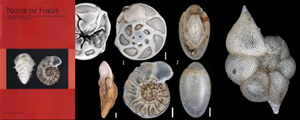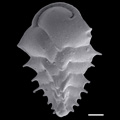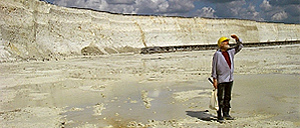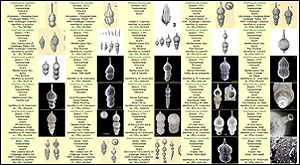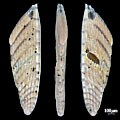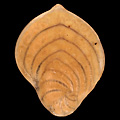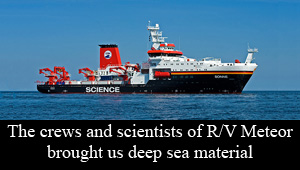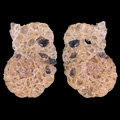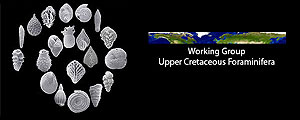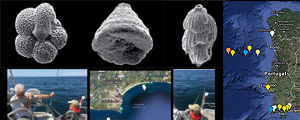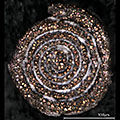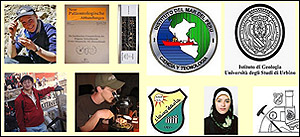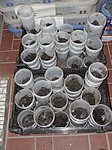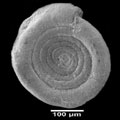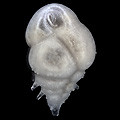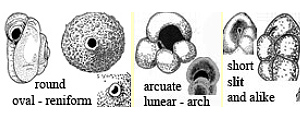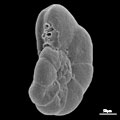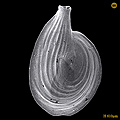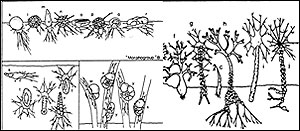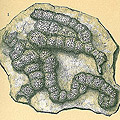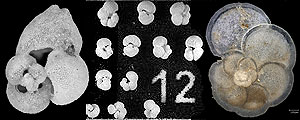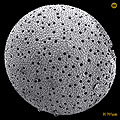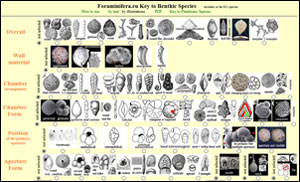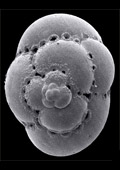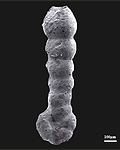Foraminifera Database - 24.000 images: searchable on taxonomy, morphology, geological time and geography (original) (raw)
Foraminifera Database - illustrated catalog
This foraminifera database provides an illustrated catalog run by the Foraminifera.eu lab.
It is searchable on taxonomy, morphology, geological time and geography.
to the Database Query
Online 20th of April 2025: 24.153 illustrations of foraminifera (2.025 genera)
News and background:
April 2025: Pliocene foraminifera from Le Puget-Sur-Argens.
Gunnar Kircher, fossil collector from Wiesbaden contributed images of 127 Zanclean (Pliocene) foraminifera from Le Puget-sur-Argens in southern France. He extracted them from material of the former claypit Les Escaravatiers.
Februar 2025: Miocene Foraminifera from Sardinia.
Cesare Brizio contributed 281 images of Langhian (Miocene) foraminifera from Su Luttone on Sardinia, Italy. He extracted them from material of the Fangario Clays Formation (Middle Langhian). See more ....
November 2024: Foraminifera from Seas around Sulawesi.
Thirtyeight images of recent foraminifera from the Gulf of Tomini and the Gulf of Boni were contributed by Kresna Tri Dewi, formerly Geological Agency of Indonesia. See more ....
October 2024: Foraminifera from the Norwegian Trench and Skagerrak.
More than 80 samples from cruises of the MAREANO project were provided to us in Trondheim by the Geological Survey of Norway (Daniel H. Wiberg). We started to extract and photograph specimens as part of our effort to portray foraminifera of the Greater North Sea. To date the identifications are being discussed and more photographs are added. See more ....
June 2024: Sampling in the Kimmeridge Clay Formation
In the first two weeks of June main sampling will be done with support of The Etches Collection. From our feasibility study based on single samples we have already photographed a number of species. See more ....
September 2024: Paper on Oligocene foraminifera published.
Read my open access paper Hesemann, M., Ketelsen D. 2024. Foraminifera in the glacial erratic rock Sternberger Gestein from northern Germany. Journal of Foraminiferal Research 2024, 54 (3): 249–263, 7 plates. .... to the paper.
March 2023: Paper on Mauritanian Foraminifera published.
Read my open access paper Hesemann, M. et al., 2023: Benthic foraminiferal assemblages from the Mauritanian shelf and upper slope and their association with cold-water coral habitats. It contains 31 plates. .... to the paper.
FORAMINIFERA.EU LAB
A Citizen Science Project
The Foraminifera.eu Lab (FEULAB) is run by a team of avocational scientists, who gets great support by professionals and amateurs. We want to foster the interest in foraminifera as an important but mainly neglected form of life. By documenting the many species we want to rise the awareness for the biodiversity crisis in general. Our freely accessible database is a major outcome. We work out of natural enthusiasm on a strictly non-commercial basis. ... read more

The Foraminifera.eu Database (FEUDAT)
FEUDAT contains to date 24.000+ datasets each with an image. It is freely searchable on a range of criteria, which are on taxonomy, morphology, geography, geological time, collection, fauna and more. The result is presented as a plate with up to 500 images. Contributors may find their collection of foraminifera better accessible than ever. to the database // It is described in Hesemann, M. 2015: The foraminifera.eu database: concept and status. Palaeontologia Electronica 18.3.48A: 1-14 to the PDF
PROJECTS
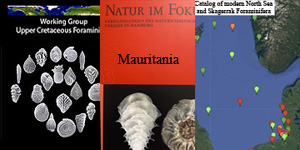
With you, our contributors we work on projects. We extract, photograph, identify forams and interpret assemblages biologically and/or stratigraphically. We work with amateurs and professionals on simple to high levels. To process a beach sample from a school is easily done (see Greek Schools Project). Working on core or deep-sea material is complex and may result in a peer reviewed paper (Hesemann, M. 2020: Foraminifera in the glacial erratic rock Heiligenhafener Kieselgestein of northern Germany in MP 66(5):397-418 Abstract). Please contact us with your proposal.
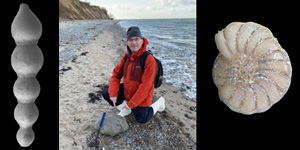
Foraminifera in glacial erratics
Northern Germany is covered by glacial erratics brought to us during the ice ages. Foraminifera may be found in sedimentary erratics of marine origin. They are often well preserved and may be used to date the erratics. We thank the many contributors of the glacial erratics society for their help. We have extracted, photographed and identified so far 650+ specimens.
Publications were made on forams in Cretaceous and Eocene erratics and papers on Oligocence and Upper Jurassic material are in the making.
Modern North Atlantic foraminifera
Based on hundreds of samples ranging from the beach to abyssal plains we are constantly working on foraminifera from the North Atlantic. In 2023 we are focussing on our catalog of Modern Greater North Sea foraminifera. A peer reviewed paper on benthic forams associated with cold water corals off Mauritania was published. A submitted paper on deep sea forams is under review. Our work on samples from the Reykjanes Ridge resulted in 240+ photographed specimens and that on the Mediterranean Sea in 700+ datasets.
Upper Cretaceous Foraminifera
The Working group of Upper Cretaceous foraminifera has created over time a catalog of 2700+ Upper Cretaceous Foraminifera. It started with own finds from Upper Campanian quarries near Hamburg and was soon substantially enlarged by contributions of images by professionals. The enlargement is ongoing and your contribution is welcome to enlarge the coverage. ... to the catalog
Alaskan modern foraminifera
Fisherwomen Karen L. Johnson contacted us with the idea to build an illustrated catalog of foraminifera from off Sitka, southern Alaska. She found sediments attached to her fishing gear with lots of foraminifera in them. We received anchor-mud material collected by Karen and her colleagues from the waters off Sitka. You may find images made by Karen and us partly on iNaturalist and here ....
Catalog of Portuguese Foraminifera
The Working group of Portuguese Foraminifera has created a catalog of 800+ foraminifera from Portugal. The basis was 8 years of field work in the Algarve by Brian and Michael. Portuguese professionals contributed many SEM images. The catalog comprises specimens from recent waters and fossil foraminifera from the Miocene, Cretaceous and Jurassic. ... to the catalog
CONTRIBUTION AND BENEFITS
How to contribute
We work strictly non commercial, money can"t be contributed. Raw material andpicked specimens allow us to work on interesting stuff und explore new topics. With Images we may enlarge the coverage of the database. Comments and proposals often lead to improvements. Invitation to talks, field work and workshops allows us to get in touch with interested people. Provided publications preferably as PDF help us to improve our skills. Contact us
[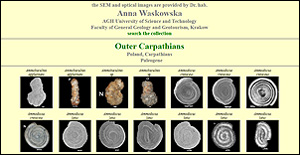 ](collection.php?collname=Anna Waskowska&aktion=suche)
](collection.php?collname=Anna Waskowska&aktion=suche)
Benefits
As a contributor you will get your own contributors page. It is freely online accessible to you and everyone interested. You will find your collection in our well structured database and thus made accessible over a substantial range of criteria. We add contributed images free of charge and check identifications. To a limited extent and willingness of the team we process raw material, extract forams, shoot optical images and identify specimens. ... to the list of contributors
BEST PRACTICE
Microslides
Foraminifera should be properly stored in microslides. There are different types and manufacturers, the ones we use are described here
FORAMINIFERA - EXPLAINED
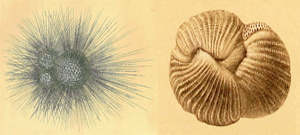
What are Foraminifera
Foraminifera, in short forams, are single-celled organisms which live in the oceans. They consist of cytoplasma, which is stabilized and protected by an inner shell called test. Either they float in the water column (planktonics) or live on the sea floor (benthics). Of the approximately 6,000 species living today, only about 50 species are planktonic. It is estimated that there are about 42.000 species, which went extinct.
The word Foraminifera
is derived from the Latin words "foramen" (=opening) and "ferre" (=to bear). Usually they have one major opening called aperture and miniature smaller ones. Some have secondary apertures. Within the taxonomy of forams the openings only play a minor role. ... more on apertures
Where do Foraminifera live ?
Foraminifera are abundant all over the oceans. A few species live in freshwater environments. Forams live in the deep sea, open waters, near shore and even in areas only partly covered by sea water. Each niche has a specific mixture of species, called fauna. Explore the foraminifera in todays oceans via the zoomable map of our finds or the database-query choosing an ocean, area and/or locality.
Benthic Foraminifera
They live on the seafloor and adapt to the local habitat. Major factors of such seafloor habitats are food supply, light, predators, water-depth, salinity, temperature and substrate. In the fossil record an assemblage of benthic foraminifera may lead to an understanding of the ancient habitat. Benthic foraminiferal species show a wide range of life styles and forms. ... to the images
Planktonic Foraminifera
They drift in the oceans. Their habitat are open waters from the surface to several hundred meters below. About 50 species live in todays oceans. Wide areas of the ocean floors are covered by their remains, the so called tests. They are used for palaeontological and stratigraphical studies (PDF) by Prof. Kucera.... to the images
Taxonomy of Foraminifera
As single celled organisms with a nucleus, foraminifera belong to the kingdom of protists. They build an own phylum with 80.000 described species. The taxonomy is for more than 99% of the species based on the morphology of the test. The wall material of the test and the chamber arrangement are the most important features to describe benthic species. Consult our key to benthic species. For planktonics the test surface and chamber arrangement are important. Consult ourkey to planktonic species. Read more.
Fossil Record of Foraminifera
The stratigraphic range of foraminifera extends from before the Cambrian till today. The first species had organic tests or were simple agglutinated tubes. In the Paleozoic Fusulinida dominated. In the Mesozoic an enormeous radiation of species took place till substantial extinctions at the end of the Cretaceous. The Cenozoic had a huge radiation. In total 80.000 species are described and used in the biostratigraphic studies. ...to the fossil record














